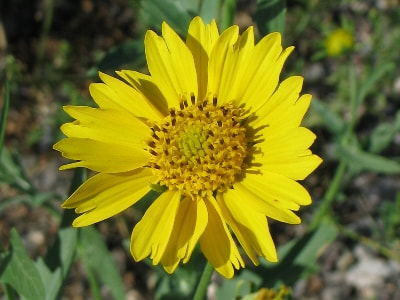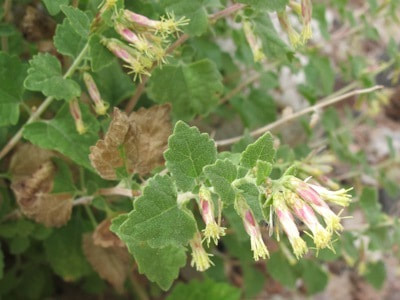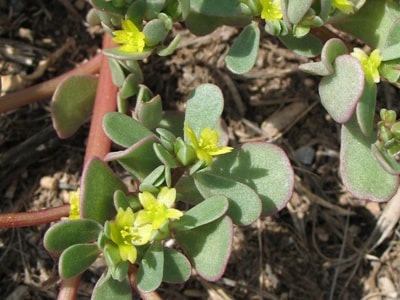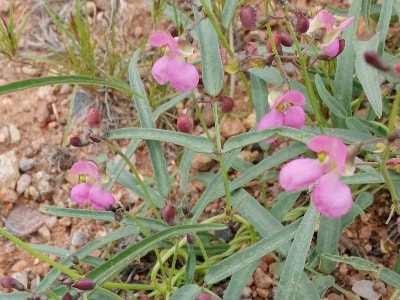|
Found in waste areas, pastures, roadsides
Seen blooming on September 25, 2018 by CR 74 in Chamita Not all the yellow flowers growing in profusion along our roadsides are sunflowers and chamisa. Another erect, often tall, showy sunflower-like plant is the Golden Crownbeard. It grows to 3 feet tall with fine white hairs on stem, underside of leaves and bracts. The leaves are gray-green, triangular and toothed. Leaves and flowers are smelly. The flower heads are up to 2" across with yellow centers and yellow petals that have three teeth at the tip. The Hopi and Navajo make the plant into tea and use it as a fever wash and to treat spider bites. The Navajo also use a liquid of strained leaves for stomach trouble, chew petals for good luck in hunting and wear the flowers in a hat band as protection from lightning. Source. If you want to identify a different flower then you might find it useful to check what was blooming this time last year. If you cannot identify a flower from the website send a photo and where you took it to contact@rockymountainsflora.com. Read online for tips.
0 Comments
Found in canyons, on rocky slopes
Seen blooming on September 18, 2018 in Plaza Blanca The California Brickellbush is a many-branched shrub growing 2 to 3 feet high and wide, with heart-shaped, veined, fuzzy, toothed leaves. It has many small insignificant flowers which are cylindrical with purple-tinged bracts, no petals and whitish disk flowers. It produces dandelion-like seeds and a delicious fragrance in the evenings. It was used traditionally as a lotion for sores, for cough and fever, as a rub for headaches and as a tea. Source. If you want to identify a different flower then you might find it useful to check what was blooming this time last year. If you cannot identify a flower from the website send a photo and where you took it to contact@rockymountainsflora.com. Read online for tips. Found in fields, at roadsides
Seen blooming all summer by roadsides and in yards This bushy plant with purple flowers is so common that we hardly notice it. Alfalfa is an escapee from cultivation. It has clover-like leaves and grows to 3 feet tall and wide. It is very drought resistant and produces abundant flowers, blooming from late spring through the fall. Flower color ranges from pale blue to dark purple, but it can be white or yellow. Alfalfa is one of the oldest cultivated plants, and it is used as livestock forage, as a highly nutritious food for humans, and as herbal medicine. It is considered to have the highest nutritive value of all fodder plants. Alfalfa has been used for numerous ailments in traditional folk medicine throughout the ages including menopausal symptoms, arthritis, indigestion, liver disorders, hemorrhoids, bleeding gums, asthma, anemia, high blood pressure, high cholesterol, osteoporosis, diabetes, eczema, constipation and burns. Source. If you want to identify a different flower then you might find it useful to check what was blooming this time last year. If you cannot identify a flower from the website send a photo and where you took it to contact@rockymountainsflora.com. Read online for tips. Found in moist, sunny, open, disturbed areas Seen blooming on August 30, 2018 by the Rio Chama Little Hogweed is a spreading plant with succulent, often reddish stems and succulent, spoon-shaped leaves; the flowers are small and yellow and open only on hot, sunny days. It is considered a beneficial weed because all parts of the plant are edible, raw or cooked. It is quite nutritious because it is unusually high in omega-3 fatty acids and contains significant amounts of vitamins A and C, as well as calcium, iron, magnesium and potassium and antioxidants. It is sometimes used as fodder and is fed to poultry to reduce egg cholesterol. It was used traditionally as an ointment for burns. Source. If you want to identify a different flower then you might find it useful to check what was blooming this time last year. If you cannot identify a flower from the website send a photo and where you took it to contact@rockymountainsflora.com. Read online for tips. Found on dry hillsides
Seen blooming on August 27, 2018 in Red Wash Canyon Slimleaf Bean is a long twining and trailing plant with leaves divided into three narrow leaflets. Pink, pea-like flowers grow from the leaf axils. Flowers are less than ½ inch long and have five petals, one of which is tightly coiled. Narrow seed pods are up to 3" long. I was surprised to learn that this slender little plant with delicate flowers was used to strengthen a child. This is from the Annual Report of the Bureau of American Ethnology to the Secretary of the Smithsonian Institution published in 1915: “When an infant boy evinces timidity his father carries a small quantity of corn meal wrapped in a bit of corn husk to the warrior of his choice, and, presenting it, requests that the warrior apply the medicine to his child that he may have a brave heart and never be afraid of the enemy. Crushed leaves and blossoms with the powdered root of this plant are chewed by the officiating warrior and ejected into his hands, which he rubs over the nude body of the child; he also gives the child a small quantity of the crushed blossoms to eat. This is sure to give the boy a brave heart, and he manifests a desire to fight on the slightest provocation.” Source. If you want to identify a different flower then you might find it useful to check what was blooming this time last year. If you cannot identify a flower from the website send a photo and where you took it to contact@rockymountainsflora.com. Read online for tips. |
AuthorI am Marilyn Phillips, a native of England, whose love of nature and the outdoors from childhood brought me by a circuitous route to Crested Butte, Colorado in 1993 and 16 years later to northern New Mexico. My exploration of the many trails in these areas, my interest in wildflowers and photography, and career in computer system design came together in this creation. If you have any corrections, comments or questions, please contact me by email. Archives
September 2024
Categoriescopyright © 2020
|







 RSS Feed
RSS Feed